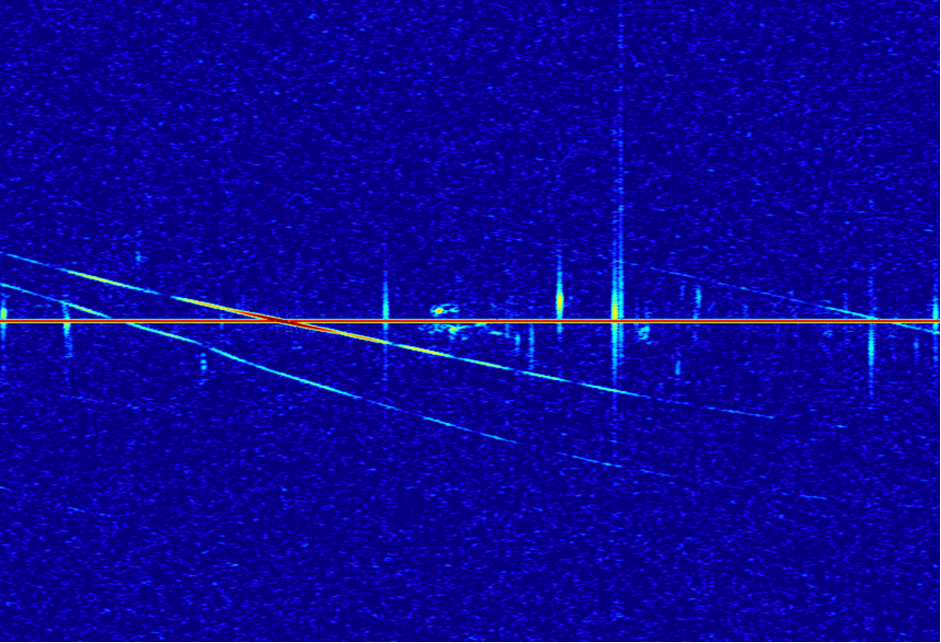Observing meteors on their path through the night sky can be a delight to watch, and there’s a very good chance you’ll spot them when there’s a clear sky. While the nighttime provides the perfect backdrop for an evening watching shooting stars, an antenna that has been installed atop one of the University’s buildings is helping both citizens and scientists to identify meteors also during the day.
To the naked eye, a meteor becomes visible when a meteoroid enters the Earth’s atmosphere at high-speed and starts to burn up, producing a trail of light in the sky. Any particles that end up landing on the Earth are then known as meteorites. It’s possible to see a particularly bright meteor during the day, but it’s not so possible to fully analyse the amount of incoming debris with eyes alone. This is because most of them just don’t produce enough light to make them visible.
The antenna is part of a network of more than 35 receivers scattered across Belgium, known as the Belgian RAdio Meteor Stations (BRAMS), with two located in Luxembourg – at the University and the Luxembourg Science Center. It was installed in October as part of an ongoing project led by the Belgian Institute for Space Aeronomy (BISA) and is enabling us to contribute toward research related to space resources.
So how does an antenna with a radio pick up signals from meteor trails between 90 and 110 kilometres above the Earth’s surface? When a meteor burns, it leaves a trail of ions and electrons behind it – a process known as ionisation. The trail can temporarily reflect a radio wave, which is emitted from a location in southern Belgium. These ‘meteor echoes’, as they’re called, can be recorded and displayed as a spectrogram. The fact that a radio is producing these observations provides two benefits over optical observations: it’s able to record data throughout the day, it’s not affected by adverse weather, and it’s sensitive to meteoroids that are much smaller in size – as these are much more frequent and would not produce any visible light.
“The purpose of this project is to investigate the population of solar system objects – origin of space resources,” said Dr. Jan Thoemel, who brought about the antenna’s installation atop the University roof. “Investigating the prevalence of space resources is a vital, ongoing process that will help humans in the long-run to spread themselves beyond Earth. Understanding what is out there is important to our long-term exploration of space, as these resources will enable us to obtain food, water, shelter, fuel and air in-situ,” he continued.
An example of one of the readings the spectrogram produces is pictured below:

The horizontal red line throughout the middle of the image is the signal that is being emitted by a beacon in Belgium, with the entire snippet representing a period of five minutes. The very long, slightly curved readings on the image represent aeroplanes as they fly over the beacon. The vertical yellow-green signals are meteors. As you can see, they’re an almost constant phenomena. The power of the signal is greater when the readings are red – in the meteors this would indicate a stronger reflection and therefore perhaps a bigger meteor.
The network collects close to 10,000 images produced per day and with no accurate algorithm to effectively process the data, the best way to currently analyse them is with the human eye. This is where citizen science comes into play, and opens up the excitement of scientific discovery to the general public. Once on the platform, users learn exactly what they’re looking for on the images and how to process a reading. In the last week of April, some 15,000 readings were processed, as users helped to analyse the data from the April Lyrids meteor shower – an annual occurrence around the 16 to 26 April. Meteor showers usually create a much wider reading, with deep red colours at their heart. Involving the public is an invaluable asset to the scientific community, and is a cost-effective method of investigation.
In-situ resource utilisation will be a strong part of the upcoming Artemis program, when NASA will return to the Moon. The mission will see a plan put into place to be more sustainable while studying and exploring the moon – a necessary step to prepare for the eventual first mission to the red planet: Mars.
Coming Soon: Asteroid Day LIVE 2021. Asteroid Day is an educational programme, run in Luxembourg by the Asteroid Foundation. From 1 June – 4 July, Asteroid Day TV is showing original films, series and learning programmes to help educate people of all ages on the role of asteroids in our solar system, as well as how we protect our planet from impacts. Asteroid Day LIVE will take place on 30 June and will feature interviews with key figures from the space missions of yesterday and tomorrow. Find out more information .here
